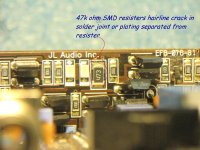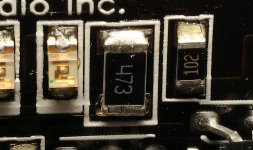Worked on 2 of these JL Audio 300/4 4 channel amps last week with similar problems on the driver boards. ( On these boards the component #'s are not silk screened on the PCB.)
The first amp had a very low output on one channel. The problem was found to be a very, very fine hairline crack in the solder joint for the upper one of the 2 47K ohm SMD resisters on the board.
The other amp had no output on one channel and the bias current was not adjustable. The problem was found to be the lower 47K ohm SMD resister- the plating had separated from the resister. This was NOT visible even under high magnification.
Attachments
Hello there, I've seen many car amps over the years from burnt pcb's etc..the last one came to me rattling and not powering up due to being bolted to the sub box this is a no no. I would agree there circuit board cracks will make the unit cut in and out...
keep amp away from the bass box well not bolted to it any...lol
even easer this chap would to use his amp in the house so I rigged him up a 750w atx power supply unit to run it on..
keep amp away from the bass box well not bolted to it any...lol
even easer this chap would to use his amp in the house so I rigged him up a 750w atx power supply unit to run it on..
Worked on 2 of these JL Audio 300/4 4 channel amps last week with similar problems on the driver boards. ( On these boards the component #'s are not silk screened on the PCB.)
The first amp had a very low output on one channel. The problem was found to be a very, very fine hairline crack in the solder joint for the upper one of the 2 47K ohm SMD resisters on the board.
The other amp had no output on one channel and the bias current was not adjustable. The problem was found to be the lower 47K ohm SMD resister- the plating had separated from the resister. This was NOT visible even under high magnification.
When you mention that the bias current was not adjustable was it stuck at 0 volts or around .45 volts? I've got a driver board that is giving me fits. I would like to fix if I could ever track down the problem. I've removed and swapped out the 47k resistors with no luck...
So a good starting point with this driver board would be replacement of all resistors? I've looked at them all with magnification and probed point to point on virtually every connection on the board and it seems to have no issue until its installed in the amp. Then the issue is intermittent.
I've narrowed it down to the driver board because I swapped a new on into the amp I pulled this one from and the amp works fine now.
Would it be suitable to pull the outputs on the channel, let it be shorted and probe around to find where the voltages go astray in hopes to try and isolate the component/s causing the issue?
I've narrowed it down to the driver board because I swapped a new on into the amp I pulled this one from and the amp works fine now.
Would it be suitable to pull the outputs on the channel, let it be shorted and probe around to find where the voltages go astray in hopes to try and isolate the component/s causing the issue?
Have you tried comparing the voltages on each terminal of each component on a good board and a bad board? That may help lead you to the defective component in the circuit.
re post #8:
For those who find a defective differential amp transistor, both differential amp transistors must be replaced with matched transistors (same production batch is close enough). Having a mismatched pair can result in various problems but most commonly excessive DC offset.
to kds9591:
If you feel that some of these posts are too far off topic, have a moderator either delete them or move them to a new thread.
re post #8:
For those who find a defective differential amp transistor, both differential amp transistors must be replaced with matched transistors (same production batch is close enough). Having a mismatched pair can result in various problems but most commonly excessive DC offset.
to kds9591:
If you feel that some of these posts are too far off topic, have a moderator either delete them or move them to a new thread.
Well, that's a tough one.If you measured every resistor and every solder joint is good you can confirm all the traces if you have a good board sitting there as well.Intermittent makes it tough.Perhaps Perry could could give you some other things to check.
Only issues I've ran into was transistors(differential pair) and a resistor here and there.Every time was evident what the problem was.
Only issues I've ran into was transistors(differential pair) and a resistor here and there.Every time was evident what the problem was.
When you mention that the bias current was not adjustable was it stuck at 0 volts or around .45 volts? I've got a driver board that is giving me fits. I would like to fix if I could ever track down the problem. I've removed and swapped out the 47k resistors with no luck...
I could just tell from monitoring the idle current when it didn't change after turning the bias pot there was a problem with that channel.
Last edited:
- Status
- This old topic is closed. If you want to reopen this topic, contact a moderator using the "Report Post" button.
- Home
- General Interest
- Car Audio
- Jl Audio 300/4 Troubleshooting Tip

